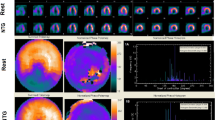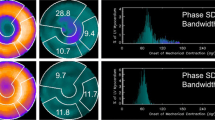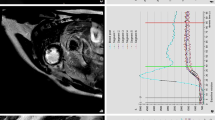Abstract
Purpose
To investigate myocardial viability in chronic ischemic heart disease by myocardial perfusion and regional contraction analysis using 256-slice MSCT coronary angiography (CCTA).
Methods
In 30 patients with prior myocardial infarction (MI), CCTA with retrospective ECG-gating and stress-redistribution thallium-201 SPECT were performed. Using the same raw data as used for CCTA, myocardial perfusion imaging (CT-MPI) was reconstructed at four phases during the cardiac cycle. Mean myocardial attenuation and wall thickness at end-systole and end-diastole were measured in the MI areas depicted by SPECT, and they were compared between viable and non-viable segments categorized by SPECT.
Results
End-systolic thickness was significantly greater for viable than for non-viable segments (12.0 ± 3.2 vs. 9.6 ± 3.5 mm, p = 0.0017). There was no difference in end-diastolic thickness. Myocardial attenuation was significantly higher for viable than for non-viable segments in the subendocardium (62 ± 13 vs. 70 ± 11 HU, p = 0.003) and the epicardium (65 ± 13 vs. 80 ± 15 HU, p = 0.0002).
Conclusion
The systolic wall thinning and epicardial low-attenuation areas were the indicative findings of CT-MPI for non-viable segments in the prior MI.





Similar content being viewed by others
References
Schroeder S, Achenbach S, Bengel F, et al. Cardiac computed tomography: indications, applications, limitations, and training requirements: report of a Writing Group deployed by the Working Group Nuclear Cardiology and Cardiac CT of the European Society of Cardiology and the European Council of Nuclear Cardiology. Eur Heart J. 2008;29:531–56.
Hecht HS, Zaric M, Jelnin V, Lubarsky L, Prakash M, Roubin G. Usefulness of 64-detector computed tomographic angiography for diagnosing in-stent restenosis in native coronary arteries. Am J Cardiol. 2008;101:820–4.
Bastarrika G, Lee YS, Huda W, Ruzsics B, Costello P, Schoepf UJ. CT of coronary artery disease. Radiology. 2009;253:317–38.
Nagao M, Matsuoka H, Kawakami H, et al. Quantification of myocardial perfusion by contrast-enhanced 64-MDCT: characterization of ischemic myocardium. AJR Am J Roentgenol. 2008;191:19–25.
Cury RC, Nieman K, Shapiro MD, et al. Comprehensive assessment of myocardial perfusion defects, regional wall motion, and left ventricular function by using 64-section multidetector CT. Radiology. 2008;248:466–75.
Kachenoura N, Veronesi F, Lodato JA, et al. Volumetric quantification of myocardial perfusion using analysis of multi-detector computed tomography 3D datasets: comparison with nuclear perfusion imaging. Eur Radiol. 2010;20:337–47.
Rodriguez-Granillo GA, Rosales MA, Baum S, et al. Early assessment of myocardial viability by the use of delayed enhancement computed tomography after primary percutaneous coronary intervention. JACC Cardiovasc Imaging. 2009;2:1072–81.
Tsai IC, Lee WL, Tsao CR, et al. Comprehensive evaluation of ischemic heart disease using MDCT. AJR Am J Roentgenol. 2008;191:64–72.
Nagao M, Matsuoka H, Kawakami H, et al. Myocardial ischemia in acute coronary syndrome: assessment using 64-MDCT. AJR Am J Roentgenol. 2009;193:1097–106.
Chao SP, Law WY, Kuo CJ, et al. The diagnostic accuracy of 256-row computed tomographic angiography compared with invasive coronary angiography in patients with suspected coronary artery disease. Eur Heart J. 2010;31:1916–23.
Manzke R, Grass M, Nielsen T, Shechter G, Hawkes D. Adaptive temporal resolution optimization in helical cardiac cone beam CT reconstruction. Med Phys. 2003;30:3072–80.
Vembar M, Garcia MJ, Heuscher DJ, et al. A dynamic approach to identifying desired physiological phases for cardiac imaging using multislice spiral CT. Med Phys. 2003;30:1683–93.
Walker MJ, Olszewski ME, Desai MY, Halliburton SS, Flamm SD. New radiation dose saving technologies for 256-slice cardiac computed tomography angiography. Int J Cardiovasc Imaging. 2009;25:189–99.
Cerqueira MD, Weissman NJ, Dilsizian V, et al. Standardized myocardial segmentation and nomenclature for tomographic imaging of the heart: a statement for healthcare professionals from the Cardiac Imaging Committee of the Council on Clinical Cardiology of the American Heart Association. Circulation. 2002;105:539–42.
Watanabe K, Sekiya M, Ikeda S, Miyagawa M, Kinoshita M, Kumano S. Comparison of adenosine triphosphate and dipyridamole in diagnosis by thallium-201 myocardial scintigraphy. J Nucl Med. 1997;38:577–81.
Bax JJ, Cornel JH, Visser FC, et al. Prediction of improvement of contractile function in patients with ischemic ventricular dysfunction after revascularization by fluorine-18 fluorodeoxyglucose single-photon emission computed tomography. J Am Coll Cardiol. 1997;30:377–83.
Pace L, Perrone-Filardi P, Mainenti P, et al. Identification of viable myocardium in patients with chronic coronary artery disease using rest-redistribution thallium-201 tomography: optimal image analysis. J Nucl Med. 1998;39:1869–74.
Reimer KA, Lowe JE, Rasmussen MM, Jennings RB. The wavefront phenomenon of ischemic cell death. 1. Myocardial infarct size vs duration of coronary occlusion in dogs. Circulation. 1977;56:786–94.
George RT, Arbab-Zadeh A, Miller JM, et al. Adenosine stress 64- and 256-row detector computed tomography angiography and perfusion imaging: a pilot study evaluating the transmural extent of perfusion abnormalities to predict atherosclerosis causing myocardial ischemia. Circ Cardiovasc Imaging. 2009;2:174–82.
Lessick J, Dragu R, Mutlak D, et al. Is functional improvement after myocardial infarction predicted with myocardial enhancement patterns at multidetector CT? Radiology. 2007;244:736–44.
Kachenoura N, Gaspar T, Lodato JA, et al. Combined assessment of coronary anatomy and myocardial perfusion using multidetector computed tomography for the evaluation of coronary artery disease. Am J Cardiol. 2009;103:1487–94.
Chung CS, Karamanoglu M, Kovacs SJ. Duration of diastole and its phases as a function of heart rate during supine bicycle exercise. Am J Physiol Heart Circ Physiol. 2004;287:H2003–8.
Wiggers CJ. Studies on the consecutive phases of the cardiac cycle: I. The duration of the consecutive phases of the cardiac cycle and the criteria for their precise determination. Am J Physiol. 1921;56:415.
Wiggers CJ. Studies on the consecutive phases of the cardiac cycle: II. The laws governing the relative durations of ventricular systole and diastole. Am J Physiol. 1921;56:439.
Weigold WG. Low-dose prospectively gated 256-slice coronary computed tomographic angiography. Int J Cardiovasc Imaging. 2009;25:217–30.
Weissler AM, Harris WS, Schoenfeld CD. Systolic time intervals in heart failure in man. Circulation. 1968;37:149–59.
Herzog C, Arning-Erb M, Zangos S, et al. Multi-detector row CT coronary angiography: influence of reconstruction technique and heart rate on image quality. Radiology. 2006;238:75–86.
Klass O, Walker M, Siebach A, et al. Prospectively gated axial CT coronary angiography: comparison of image quality and effective radiation dose between 64- and 256-slice CT. Eur Radiol. 2010;20:1124–31.
Bae KT. Intravenous contrast medium administration and scan timing at CT: considerations and approaches. Radiology. 2010;256:32–61.
Perisinakis K, Seimenis I, Tzedakis A, Papadakis AE, Damilakis J. Individualized assessment of radiation dose in patients undergoing coronary computed tomographic angiography with 256-slice scanning. Circulation. 2010;122:2394–402.
Author information
Authors and Affiliations
Corresponding author
About this article
Cite this article
Higuchi, K., Nagao, M., Matsuo, Y. et al. Evaluation of chronic ischemic heart disease with myocardial perfusion and regional contraction analysis by contrast-enhanced 256-MSCT. Jpn J Radiol 31, 123–132 (2013). https://doi.org/10.1007/s11604-012-0159-3
Received:
Accepted:
Published:
Issue Date:
DOI: https://doi.org/10.1007/s11604-012-0159-3




